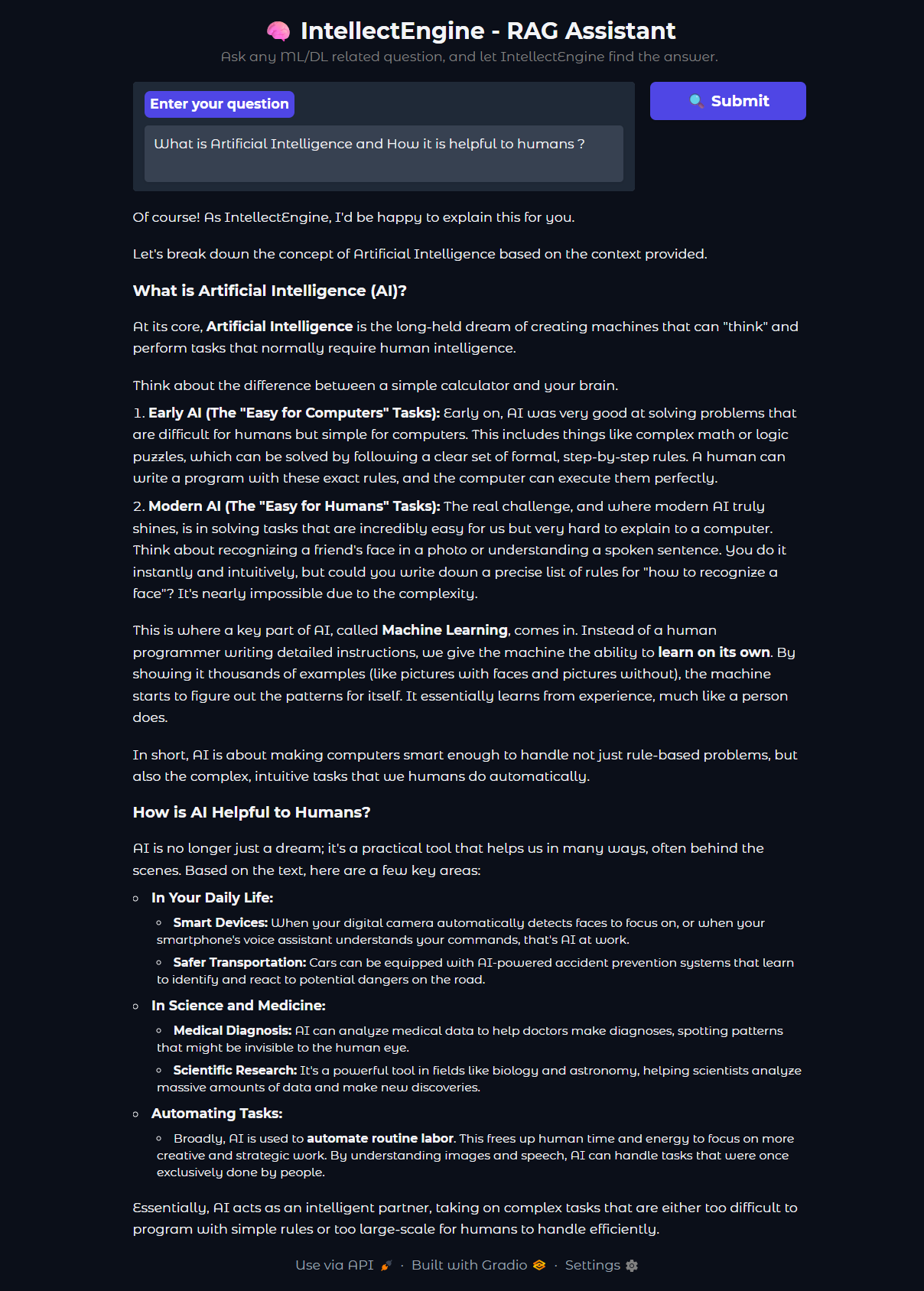📘 IntellectEngine: Retrieval-Augmented Generation (RAG) Application for ML/DL Knowledge Base
🔑 Abstract
This project presents IntellectEngine, a Retrieval-Augmented Generation (RAG) application designed to provide contextual, reliable, and explainable answers to machine learning and deep learning queries. The system integrates FAISS-based vector search with Google Generative AI (Gemini) to retrieve relevant knowledge from standard textbooks and generate natural language answers. A Gradio-based interface makes the system interactive and user-friendly.
📖 Introduction
Traditional large language models (LLMs) often suffer from hallucinations when asked domain-specific questions without access to a trusted knowledge base. To overcome this limitation, RAG pipelines combine external data retrieval with generative reasoning.
In this project, we applied the RAG methodology to the domain of machine learning and deep learning education. The system was designed to:
-
Support academic learning by answering conceptual questions.
-
Reduce hallucinations by grounding responses in trusted textbooks.
-
Provide a clean and usable interface for end users.
🎯 Domain & Use Case
IntellectEngine is designed as a knowledge assistant for Machine Learning and Deep Learning.
It is best suited for:
-
Explaining ML/DL concepts (e.g., gradient descent, backpropagation, CNNs, transformers).
-
Answering theory-based questions from textbooks, lecture notes, and research papers.
-
Supporting learners and researchers with context-grounded, reliable answers.
The system ingests PDFs of ML/DL resources and builds a knowledge base, making it a specialized educational RAG assistant, not just a generic chatbot.
⚙ Methodology
The system follows a modular pipeline:
A[📂 Raw PDFs] --> B[🧹 Preprocessing] B --> C[🔍 FAISS Vectorstore] C --> D[🤖 RAG Pipeline (Retriever + Generator)] D --> E[💻 Gradio Web App]
1. Data Collection
-
Core machine learning and deep learning textbooks (e.g., Bishop, Goodfellow et al., Hastie et al.).
-
Stored under data/raw/ for preprocessing.
2. Preprocessing
-
Extracted text with pypdf.
-
Chunked documents into passages with nltk.
-
Stored chunks + metadata in data/processed/.
3. Vectorstore Construction
-
Used FAISS to store embeddings.
-
Generated embeddings with Google Gemini via langchain-google-genai.
-
Saved index in data/faiss_index/.
4. RAG Pipeline
-
Implemented retriever + generator using LangChain.
-
Retriever fetches top-k relevant chunks.
-
Generator (Gemini) synthesizes a natural language response grounded in retrieved context.
5. Interface
-
Built using Gradio.
-
Features: query input, submit button, loading indicator, styled results panel.
⚙️ Installation
-
Clone the Repository
git clone https://github.com/shanks1554/IntellectEngine.git cd IntellectEngine -
Create virtual environment
python -m venv .venv source .venv/bin/activate # On Windows: .venv\Scripts\activate -
Install Dependencies
pip install -r requirements.txt -
Set environment variables
Create a .env file in the root directory and add you GEMINI API KEY:
GEMINI_API_KEY = your_api_key
▶️ Usage
Run the application
python main.py
This will launch a Gradio web interface where you can enter queries.
🧪 Experiments
We evaluated IntellectEngine by running test queries across three categories:
Conceptual Understanding
-
Query: “Explain supervised learning in simple terms.”
-
Observation: Retrieved relevant sections from Bishop’s textbook; response was accurate and accessible.
Mathematical Foundations
-
Query: “What is the bias-variance tradeoff?”
-
Observation: Correctly cited core definitions, avoided hallucination.
Practical Guidance
-
Query: “How does gradient descent work in deep learning?”
-
Observation: Retrieved structured explanation and example; generator expanded with intuitive language.
📊 Results
-
Accuracy: Significantly reduced hallucinations compared to zero-shot Gemini responses.
-
Efficiency: FAISS lookup time < 200 ms on 7,000+ chunks.
-
Usability: Gradio interface allowed non-technical users to interact easily.
Sample Output:
Query
Explain supervised learning in simple terms.
Answer:
Of course. Here is a simple explanation of supervised learning.
Think of supervised learning like teaching a student using flashcards.
On one side of the flashcard, you have a question or a problem (e.g., a picture of an animal). On the other side, you have the correct answer (e.g., the word "Dog").
In machine learning:
- The "flashcards" are your data.
- The "correct answers" are called labels.
The goal is to show the AI thousands of these labeled examples. By studying them, the AI learns the patterns and figures out the relationship between the question and the answer on its own. After enough training, you can show it a new flashcard it has never seen before, and it can predict the correct answer.
There are two main things you can do with this method:
-
Classification (Categorizing things): This is for sorting items into groups. A perfect example is a spam filter. You train the AI by showing it thousands of emails that are already labeled as either "Spam" or "Not Spam." The AI learns what spam looks like. Then, when a new email arrives, it can accurately classify it.
-
Regression (Predicting a number): This is for predicting a specific value. Imagine you want to predict a house's price. You would feed the AI data on many houses, including their features (square footage, number of bedrooms) and, most importantly, their actual selling price (the label). The AI learns how these features influence the price, so it can then predict a price for a new house.
In short, supervised learning is all about learning from examples where you already know the right answer. You act as a "supervisor" by providing the AI with a complete answer key to learn from.

Conclusion
IntellectEngine demonstrates how Retrieval-Augmented Generation can enhance domain-specific learning by grounding LLM outputs in trusted resources. This project highlights the importance of combining symbolic retrieval with neural generation for reliable AI systems.
Future improvements could include:
-
Multi-document summarization.
-
Citation display with page numbers.
-
Multi-turn conversational memory.